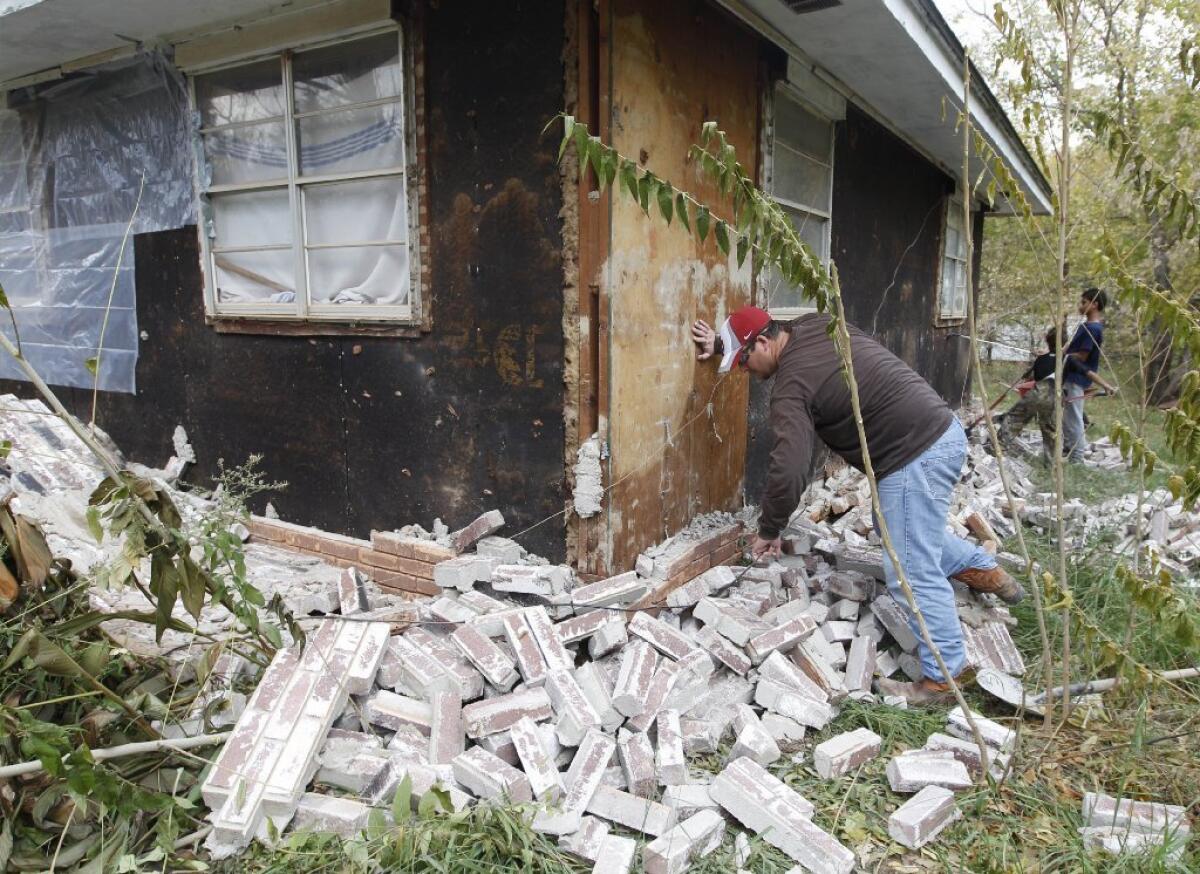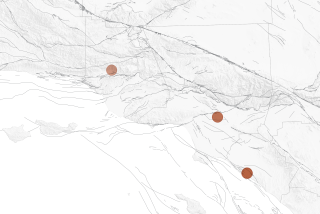Study links Oklahoma earthquake swarm with fracking operations

- Share via
Oklahoma has seen a boom in two things in recent years: oil and gas production and earthquakes.
To many residents, the timing says it all. Before the oil and gas industry started drilling so many underground injection wells, they say, it was rare to feel an earthquake. Today, Oklahoma is the second-most seismically active state in the continental United States, behind California.
Now they have some fresh scientific evidence to back up their observations. Researchers from Cornell University and the University of Colorado say a large swarm of earthquakes in central Oklahoma was probably caused by activity at a few highly active disposal wells, where wastewater from drilling operations — including hydraulic fracturing — is forced into deep geological formations for storage.
Four high-rate disposal wells in southeast Oklahoma City probably induced a group of earthquakes known as the Jones swarm, which accounted for 20% of the seismicity in the central and eastern United States between 2008 and 2013, the team reported Thursday in the journal Science.
The Jones swarm, named for a small town east of Oklahoma City, included more than 100 earthquakes of magnitude 3 or greater during that five-year period. The four wells dispose of more than 4 million barrels of fluid monthly. Hydraulic fracturing, or fracking, involves shooting a high-pressure mixture of water, sand and chemicals deep underground to extract oil and natural gas. The resulting wastewater is often forced underground as well.
When fluid is injected into rock formations, it increases pressure in the pores of those formations, said study senior author Shemin Ge, a hydrogeology professor at the University of Colorado, Boulder. The increased pressure can trigger earthquakes in preexisting faults or other areas of geological weaknesses, she said.
For the Science study, researchers created a three-dimensional hydrogeological model of the underground rocks to simulate the way injection wells would spread pressure through the pores. The computer model used actual injection rates at 89 wells within 31 miles of the Jones swarm between 1995 and 2012, including the four high-rate wells in southeast Oklahoma City.
The pressure in the pores increased with time and migrated through the ground away from the wells, the researchers found. Ge compared the effect to water being injected into a sponge set between two stiff wooden blocks.
The “more fluid you put in, the more pressure the sponge has to deal with,” she said. As the process continues over time, “the area or volume within the sponge around the injection point will expand.”
And indeed, the pattern of the Jones swarm quakes corresponds closely with the way pressure from the four disposal wells spread underground, away from southeast Oklahoma City, according to the study. The earthquake swarm began within 12 miles of the four wells and spread as far as 22 miles away, the researchers reported.
“We view the expanding Jones earthquake swarm as a response to regionally increased pore pressure from fluids injected at the [southeast Oklahoma City] wells,” the scientists concluded. As the pressure continues to expand, they added, “critically stressed, optimally oriented faults are expected to rupture first.”
Katie Keranen, a geophysics professor at Cornell and the study’s lead author, said even a small change in pressure can cause a fault to rupture and trigger an earthquake.
Over time, the Jones swarm has expanded and now includes regions closer to the Nemaha fault, which runs through Oklahoma City, Keranen said. Though the fault’s orientation makes it less vulnerable and probably offers some protection, the fact that the swarm is getting closer “presents a potential hazard for the Oklahoma City metropolitan area,” according to the study.
Austin Holland, a seismologist with the Oklahoma Geological Survey in Norman, said the Science study “will help improve the scientific discussion and understanding of what’s occurring in Oklahoma.”
The state had 109 temblors measuring magnitude 3 or greater in 2013 — more than 5,000% above normal — and there have already been more than 200 such quakes this year, Holland said.
Last month, hundreds of people crowded into a town hall meeting in Edmond, Okla., to ask Holland and others why wastewater injection had not been halted, the Oklahoman reported.
Holland said stopping injection wells would rob researchers of valuable data that would help determine how to prevent the quakes, the newspaper said. One man complained: “You want to study us like animals.”
Industry officials say additional studies are needed to nail down any link between the surge in earthquakes and drilling operations. In a statement, Oklahoma Independent Petroleum Assn. President Mike Terry called the Science report “just one part of continuing research into the increase of seismic activity in Oklahoma” and said “a rush to judgment based on one researcher’s findings provides no clear understanding of the causes.”
Terry said disposal wells have been used in the state for more than 50 years and “have met and even exceeded current disposal volumes during that time.” Oil and natural gas are produced in 70 of Oklahoma’s 77 counties, so “any seismic activity within the state is likely to occur near oil and gas activity,” he said.
Follow me on Twitter @haileybranson.







